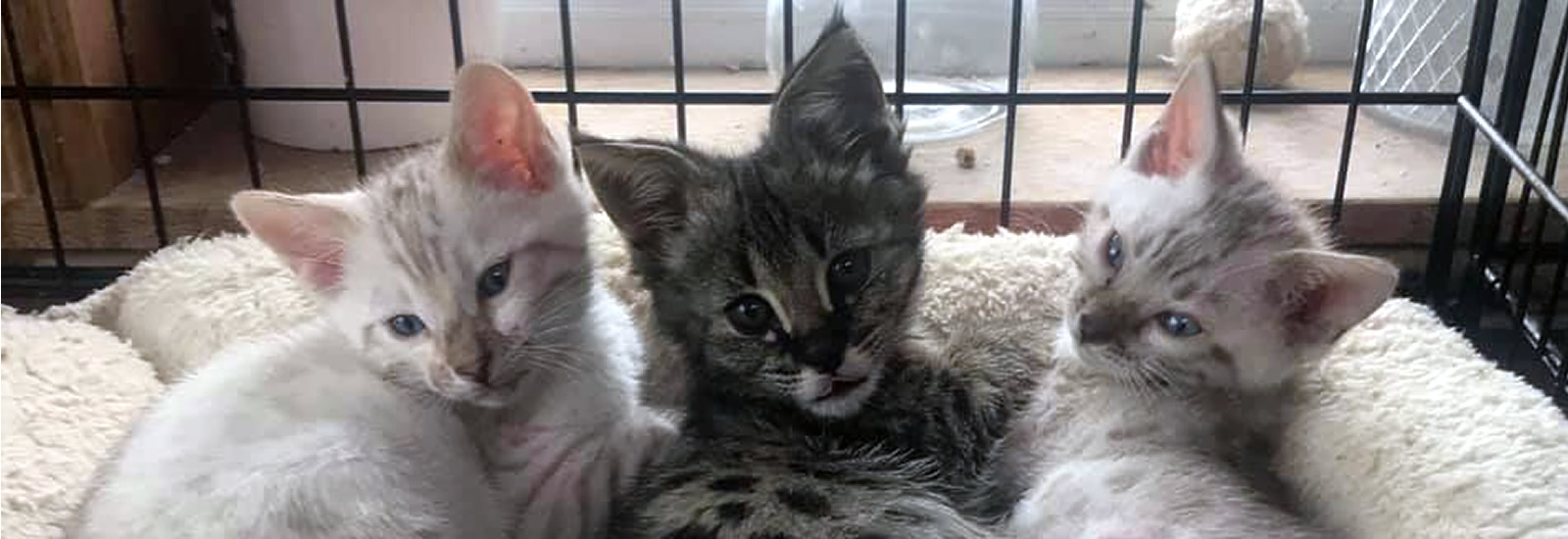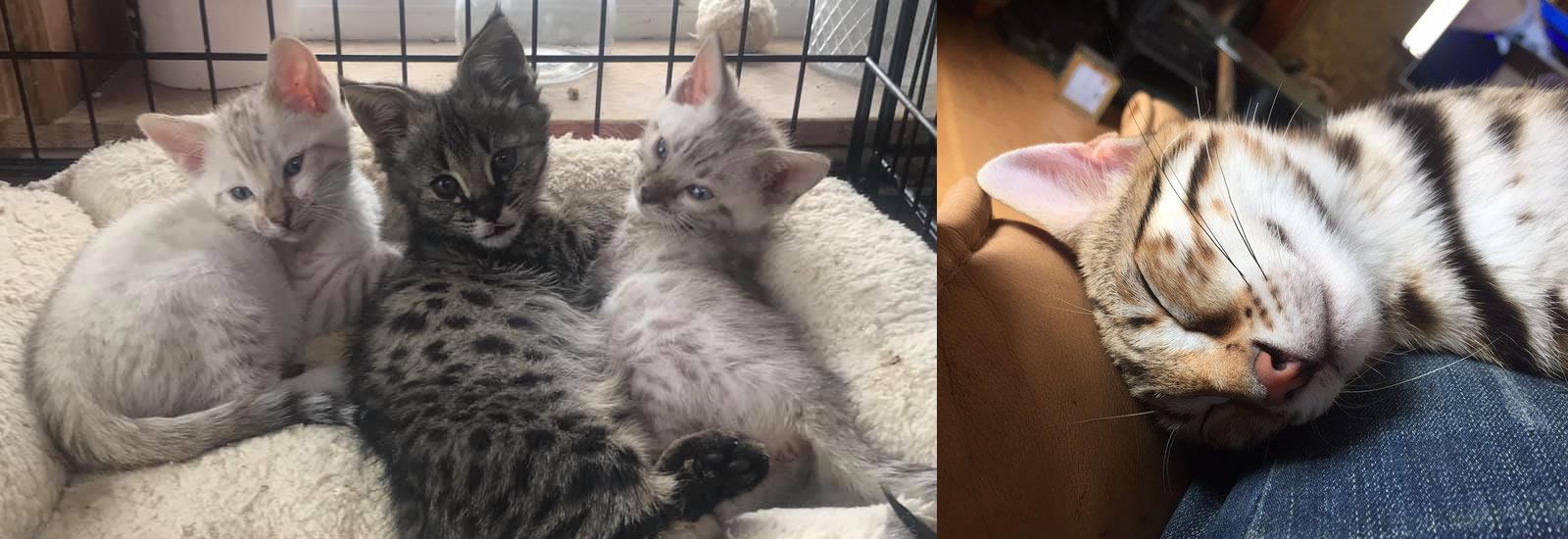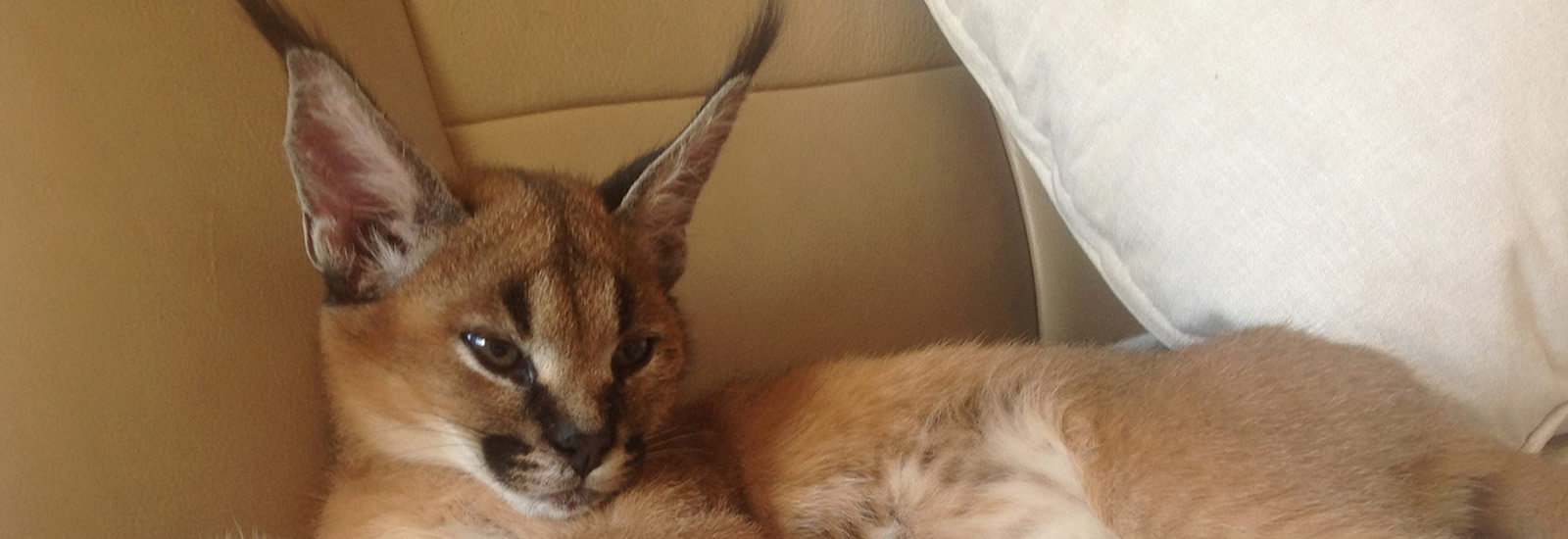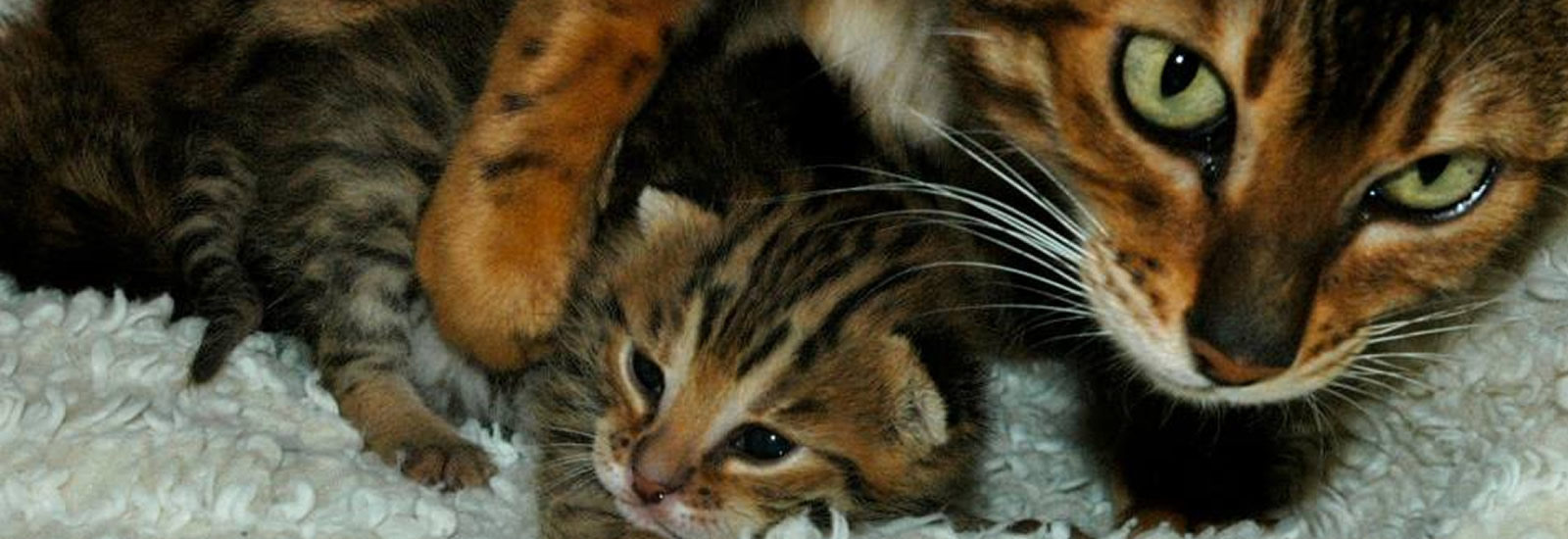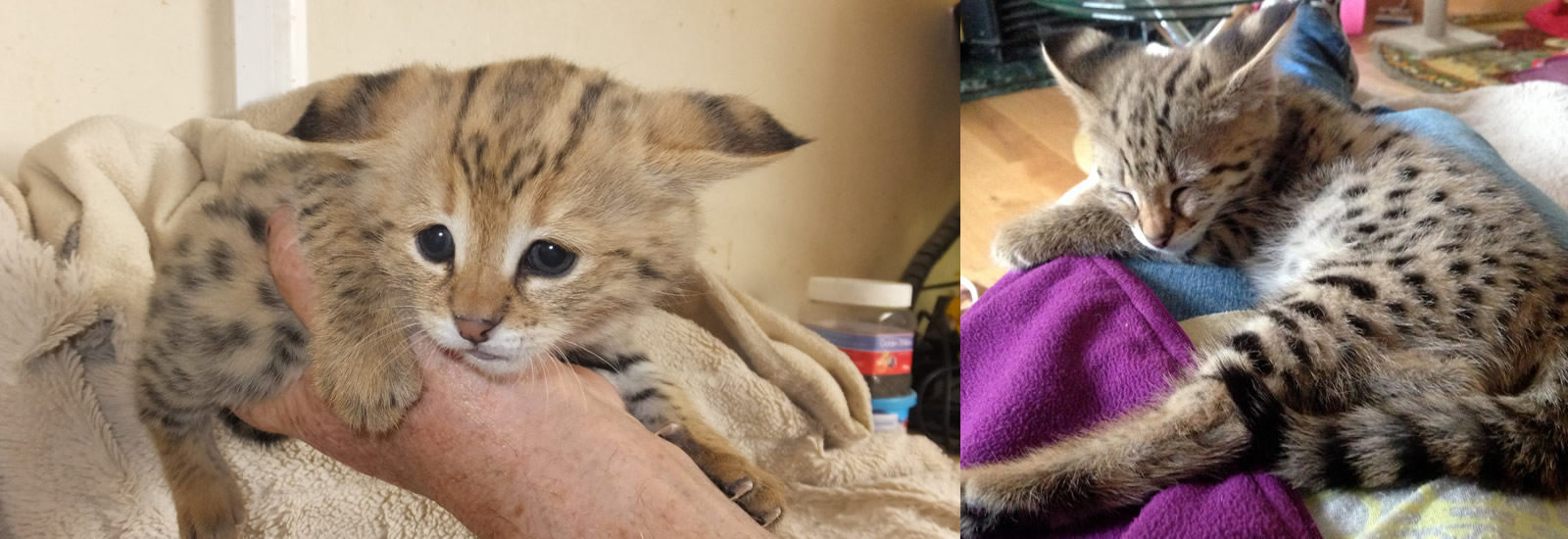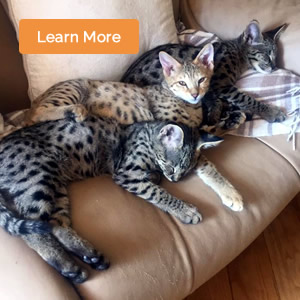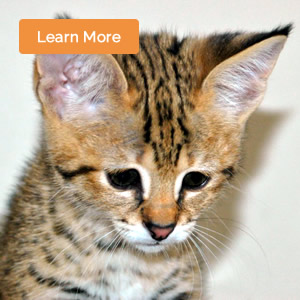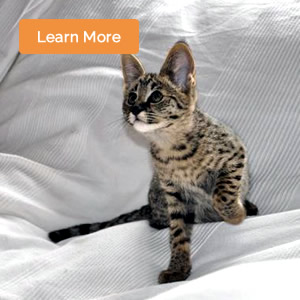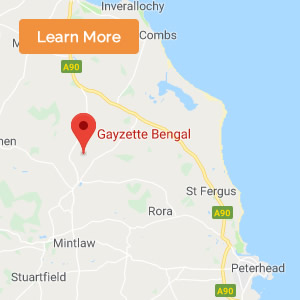Sarez Bengals - Our Story…
By C. Esmond Gay - Sarez Bengals - 2004
Bengal cats are unique because their close relatives are the magnificent leopard cats that stalk the jungles of Asia. Sarah and I fell in love with them, and fuelled by our dreams and powered by our imaginations, we quickly became pioneers of the Bengal in the UK; we were one of the first to breed them in the early 1990s, one of the first to breed all the main colours, one of the first to breed early generations - and the first to hybridise from not just one leopard cat, but from two! Our work has broken new ground in the British Bengal fancy, and with 35 TV appearances and over 100 newspaper and magazine features about them, the publicity surrounding our cats has helped to propel the breed into what it is today;
… one of the most popular types of pedigree cat in the world!
To me, cats are alluring creatures, fascinating and mystifying. They are independent and strong willed and they do not give their loyalty and affection as readily as some other domestic animals do… one has to earn their love, deserve it, and one has to work hard to gain their trust and respect, too. If one fails, then cats will always show their disdain by being aloof… but if one succeeds, then one will be blessed with utter devotion from their feline friend - and with a powerful, lifelong relationship.
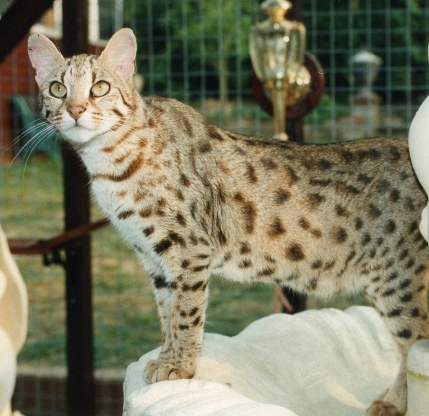 A cat’s love is special… it is the greatest of all
compliments!
A cat’s love is special… it is the greatest of all
compliments!
Animals of all kinds have been a great source of comfort to me for as long as I can remember. My father was a strict disciplinarian who would have been more at home in the Victorian era, where children “should be seen and not heard” (and beaten soundly if they were), whilst my mother, a demure, gentle and kind-hearted lady, showered me and my siblings with love. And so I was raised in a world of great contrasts.
Leopardette (F1 Female) -
Circa July 1996
One of my most poignant childhood memories was witnessing a car accident involving a stray cat, and this had a traumatic and profound affect upon my sensitive, 9 year old mind. I mourned this unknown cat for years, and every night until my mid teens, I would pray for its soul. Perhaps it’s this event that caused me to focus my love on to cats. After that, my greatest fantasy was to become a billionaire, then rescue every unwanted cat in the country, housing them in all the empty houses that I'd buy in Britain, and hiring families to look after them. How naïve and idealistic the young mind can be.
But soon after this incident, I did make a minor start by bringing home any stray cats that I found, and my ever patient mother and I would take them under our wing. I used to sit for hours, gazing in awe at these animals, mesmerised by their agile, graceful movements and captivated by their secretive yet playful characters.
 In
1987 when I was 19 years old, I found myself unceremoniously dumped
into a dingy
bedsit, and that April I
adopted my first cat, a Birman named Boo Boo.
He was the quintessential chocolate-box kitten with deep,
sapphire-blue eyes, pretty white socks and a soft, lustrous fur coat…
and nature blessed him with the most loving personality than anyone
could ever wish for. Every evening I'd take him for walks around the
streets and every night he’d sleep next to me in bed, his
near-constant purr as comforting as a mother’s heartbeat is to
her unborn child. Boo Boo
has helped me through many difficult times in my life; he’s
my rock, a being on whom I can always rely - and he’s my best
friend, my dearest companion… my feline son.
In
1987 when I was 19 years old, I found myself unceremoniously dumped
into a dingy
bedsit, and that April I
adopted my first cat, a Birman named Boo Boo.
He was the quintessential chocolate-box kitten with deep,
sapphire-blue eyes, pretty white socks and a soft, lustrous fur coat…
and nature blessed him with the most loving personality than anyone
could ever wish for. Every evening I'd take him for walks around the
streets and every night he’d sleep next to me in bed, his
near-constant purr as comforting as a mother’s heartbeat is to
her unborn child. Boo Boo
has helped me through many difficult times in my life; he’s
my rock, a being on whom I can always rely - and he’s my best
friend, my dearest companion… my feline son.
Esmond Gay & Boo Boo
(Birman) - Circa 1987
As a child, Sarah only ever had a guinea pig for a pet, but my adoration for cats must have rubbed off on her because by 1992, she and I shared our home not just with my “first born”, Boo Boo, but also with a number of other cats. These included a rather reserved Chinchilla named Souki, a devoted, effervescent, red shaded cameo Persian called Chippie (the first cat that Sarah and I bought as a couple), a sweetly-dopey and very quirky Persian called Blue-Bell, and Sarah’s favourite; a second Birman named Kyter. By this time, my childhood fantasy had digressed (and been somewhat tamed) as I now wanted about 30 cats living with me - I never contemplated breeding them fulltime as I already had a career - but I found their love addictive and I wanted to be surrounded by them.
And so Sarah and I would often sit cuddled up on the sofa reading cat books together - and one day, whilst flicking through one, we set eyes on a photo of a Bengal - I felt as though my breath had been taken away! I was entranced by the beauty of this animal, one that not only looked like a leopard, but was also their close relative! My passion for wild cats had always been the strongest of my felid obsessions, but due to the costs and the licensing laws, owning one was impossible - yet in the Bengal I saw a stunning compromise…
In 1993, Sarah and I started to look for one, but soon found that this breed was rare and expensive - we were horrified at the £2,000 price tags attached to even late generation kittens! Back then, we were as poor as church mice and simply could not afford to spend such huge sums on pets! And so it appeared that this dream cat would never be ours.
However, prior to this, when I was 21 years old, I had bred from my Chinchilla and had loved the exhilaration of it - rearing the babies and having them scampering around my home, was a magical experience! But parting with them had been a nightmare… I adored the kittens, so much that after I had re-homed them, I ended up buying many of them back! My paternal instincts were far too strong, and so that hobby was short lived.
And then an epiphany! Perhaps I could try again, this time breeding Bengals - but I’d have to be firmer with myself - enjoy living with these cats, and let them fund themselves. It sounded so logical! And perfect for a man who has always craved a home full of felines!
This decision was a big change in our lives and Sarah and I threw ourselves into this new challenge. We became friendly with some of the kinder Bengal breeders, one of whom, Denise Carter, even suggested a prefix for us to use - a mix of both our Christian names - “Sarez”… Perfect! These events were our dream come true, and so what better way to celebrate that than to incorporate our names into it?
Cleo (Left) & Smartie
(SBT Females) - Circa Late 1993 And
around September 1993, this lady also helped us to find our first
brown spotted Bengals; two females who had been rescued in
Southampton. We went to see Sunburst Smartie
and Cleo
(Mikerdee Firebright),
who were lovely quality, but were nervous creatures due to their
tumultuous upbringings - I've never seen a cat climb 9 feet
vertically up a wall in sheer panic…
but I did that day. However, we were smitten
and we knew that our love would bring them round, and as we were able
to buy them on breeding loan, they were a brilliant start for us.
And
around September 1993, this lady also helped us to find our first
brown spotted Bengals; two females who had been rescued in
Southampton. We went to see Sunburst Smartie
and Cleo
(Mikerdee Firebright),
who were lovely quality, but were nervous creatures due to their
tumultuous upbringings - I've never seen a cat climb 9 feet
vertically up a wall in sheer panic…
but I did that day. However, we were smitten
and we knew that our love would bring them round, and as we were able
to buy them on breeding loan, they were a brilliant start for us.
“Esmond and Sarah’s kittens are an extravagance that all should enjoy - they are living works of art… and the ultimate in feline luxury…”
Debretts Magazine (1998)
Smartie & Her SBT
Kittens (Our First Litter) - January 1994 
Smartie’s babies made me realise that I wanted to dedicate my life to this unique breed - but being a perfectionist who never does anything by halves, I wanted my fiancée and I to help and improve these cats in ways that few others had before - I wanted us to make British Bengals the most magnificent in the world!
And so Sarah and I bred and sold, then reinvested the income, buying more top quality cats, mostly late generation or Stud Book Tradition (SBT) Bengals. Tinker (Nyali Tickletum), a strong minded, feisty, brown spotted female joined our family, then Buckholt Sarez Silky, a cute brown marble female with a sparkling character, and Nyali Occie, who’s a boisterous, cheeky, brown spotted Bengal (and the only F1 male in Britain). They were followed by three other brown spotted Bengals, Jansied Ladki Fern and Jansied Cheetah, both sweet natured females, plus our first stud called Jansied Nikunja, a moody cat with a funny, chirpy voice. Then, in the summer of 1994, Sugar Frostie, a graceful, swan-like, snow spotted female became a member of our growing clan, and we also rescued Buckholt Leo, an unhandleable brown spotted F2 gentle giant who nobody else wanted… so we gave him a loving home.
Tinker (Top), Silky (Left) &
Occie (Right) - Circa March 1994 
Jungle Aura (SBT Female) - Circa
August 1995 My
heart bled as I watched tears stream down this tough, middle aged
man’s cheeks when we picked up his beloved cats - and I
swore that we'd make him proud.
My
heart bled as I watched tears stream down this tough, middle aged
man’s cheeks when we picked up his beloved cats - and I
swore that we'd make him proud.
Radha (SBT Female) - Circa July 1995 His
cats introduced us to the wonders of early generation Bengals and, as
well as a leopard cat, we welcomed Occie’s two spotted
F1 sisters into our family; Leopardette (Nyali Jungle Song), a
pretty and dainty cat whose enchanting character had me smitten
within hours of her arrival, and Baby Gem (Nyali Baby Baby),
a majestic cat with a bewitching expression and who’s
undoubtedly the “supermodel” of the Bengal fancy. And
along with them came their shy American F3 brown marble mother,
Desertrose Nyali Michelle (who had been imported pregnant with
them).
His
cats introduced us to the wonders of early generation Bengals and, as
well as a leopard cat, we welcomed Occie’s two spotted
F1 sisters into our family; Leopardette (Nyali Jungle Song), a
pretty and dainty cat whose enchanting character had me smitten
within hours of her arrival, and Baby Gem (Nyali Baby Baby),
a majestic cat with a bewitching expression and who’s
undoubtedly the “supermodel” of the Bengal fancy. And
along with them came their shy American F3 brown marble mother,
Desertrose Nyali Michelle (who had been imported pregnant with
them).
Bobby Dazzler (SBT Stud) - Circa
March 1995 Michael
also sold us three other brown spotted Bengals; a second USA import
called Gogees Jungle Aura, an elegant and regal female, and
her daughter, Nyali Radha, who’s a rotund, affectionate,
but adorably-grumpy cat. Radha’s son (and Tinker’s
brother) called Nyali Bobby Dazzler, came with them and became
our second stud cat - I've never before seen such huge, owl-like
eyes, as his! We were so pleased that three generations of the same
family could now remain together!
Michael
also sold us three other brown spotted Bengals; a second USA import
called Gogees Jungle Aura, an elegant and regal female, and
her daughter, Nyali Radha, who’s a rotund, affectionate,
but adorably-grumpy cat. Radha’s son (and Tinker’s
brother) called Nyali Bobby Dazzler, came with them and became
our second stud cat - I've never before seen such huge, owl-like
eyes, as his! We were so pleased that three generations of the same
family could now remain together!
National Velvet (SBT Stud) - Circa July
1995 From
elsewhere, we bought National Velvet, a brown marble
stud with an outstandingly soft coat and a charming nature that the
“ladies” find irresistible! He was followed by two snow
spotted females; one gentle cat with an endearing personality called
Snow Angel (Iceangell), and another called Mau
(Frostiegal), appropriately named due to her talkative nature.
Later, other brown spotted Bengals joined our family including a
magnificent F3 male called Leopardette Rajah, plus Cazador
Raphael, another very handsome stud, and we bought a petite
female called Cheyanne.
From
elsewhere, we bought National Velvet, a brown marble
stud with an outstandingly soft coat and a charming nature that the
“ladies” find irresistible! He was followed by two snow
spotted females; one gentle cat with an endearing personality called
Snow Angel (Iceangell), and another called Mau
(Frostiegal), appropriately named due to her talkative nature.
Later, other brown spotted Bengals joined our family including a
magnificent F3 male called Leopardette Rajah, plus Cazador
Raphael, another very handsome stud, and we bought a petite
female called Cheyanne.
Sarez Miss World (SBT Female) - C.
July 1995 Sarez Diamond (SBT Female) - C.
March 1996
 And
over the years, from the kittens that we bred, we kept the
friendliest and the most striking, including Sarez Miss World,
a beguiling brown spotted female who sports the most adorable goatee
beard. We also kept Sarez Diamond, who’s a pearlescent
snow marble female with a bubbly, friendly character, and her playful
brown marble sister named Sarez Amber. Sarez Natala
followed… she’s a breathtaking brown marble with a
thick, plush coat that’s covered in deep black markings and has
what looks like gold dust sprinkled all over her - even Harrods
owner, Mohamed Al Fayed, couldn’t pry her from us! We also kept
Daneka (Sarez Worlds Alike), a gorgeous brown spotted
female who’s the exact double of her mother (Sarez Miss
World), hence the play on words, and finally Sonny
(Sarez Sundance), who is undisputedly the best brown spotted stud
that we’ve ever bred.
And
over the years, from the kittens that we bred, we kept the
friendliest and the most striking, including Sarez Miss World,
a beguiling brown spotted female who sports the most adorable goatee
beard. We also kept Sarez Diamond, who’s a pearlescent
snow marble female with a bubbly, friendly character, and her playful
brown marble sister named Sarez Amber. Sarez Natala
followed… she’s a breathtaking brown marble with a
thick, plush coat that’s covered in deep black markings and has
what looks like gold dust sprinkled all over her - even Harrods
owner, Mohamed Al Fayed, couldn’t pry her from us! We also kept
Daneka (Sarez Worlds Alike), a gorgeous brown spotted
female who’s the exact double of her mother (Sarez Miss
World), hence the play on words, and finally Sonny
(Sarez Sundance), who is undisputedly the best brown spotted stud
that we’ve ever bred.
Sonny (SBT Stud) - Circa
February 1998
W e
knew that good socialisation is important for these early generation
or filial Bengals (F1s, F2s and F3s), due to their proximity
to the wild leopard cat (the number denotes how far removed they
are), and so we gave them as much of our time as possible. And
despite them being adults, we soon formed very strong relationships
with them, with Leopardette and Baby Gem bonding
closely to me, and Occie to Sarah. Their increased wild blood
causes them to express their affection in an intense, obsessive and
puppy-like manner, and that makes them stand out - these F1s have
since become our favourite Bengals, something I’m a little
ashamed of as I know that all our cats are special in their own ways,
no matter what their generation, colour or quality. But I still can’t
help it.
e
knew that good socialisation is important for these early generation
or filial Bengals (F1s, F2s and F3s), due to their proximity
to the wild leopard cat (the number denotes how far removed they
are), and so we gave them as much of our time as possible. And
despite them being adults, we soon formed very strong relationships
with them, with Leopardette and Baby Gem bonding
closely to me, and Occie to Sarah. Their increased wild blood
causes them to express their affection in an intense, obsessive and
puppy-like manner, and that makes them stand out - these F1s have
since become our favourite Bengals, something I’m a little
ashamed of as I know that all our cats are special in their own ways,
no matter what their generation, colour or quality. But I still can’t
help it.
Sarez Natala (SBT Female) -
September 2001
Esmond Gay & Leopardette (F1) -
Circa August 1995 
And her kitten, Sarez Pharaoh, was phenomenal! Even at just a few weeks old, he had a wonderfully pale coat, adorned with huge, pitch black spots, a short, thick bushy tail and an astonishingly wild face. Sarah and I were so excited, and like first-time parents, we doted on this friendly little kitten!
Sarez Pharaoh (F2 Male) - Circa
October 1995 
“Esmond and Sarah’s kittens are some of Mother Nature’s greatest masterpieces - quite simply, they are the epitome of perfection…”
Goodlife Magazine (2002)
As our burgeoning Bengal family grew to around 60 cats and kittens, we bought a large estate in Bedfordshire, giving them vast amounts of indoor and secure outdoor space in which to roam. And today, despite their numbers, Sarah and I remain as hands on and as intimate with our many “children” as we were in the early days, and relish each one’s unique temperament, mannerisms and funny little traits. Like all Bengals, our cats are very sociable and overly intelligent due to their closeness to the wild, and they have an abundance of energy - seeing our mischievous feline-whirlwinds dashing around our home is like watching exuberant little cubs playing in the jungle!
Esmond Gay & Sarez Bengal
Kittens - Circa October 1995 
True to our family values, we never keep our kittens in outside pens; as our first two rescued Bengals proved, that is highly detrimental to their characters. We believe that there is little point in owning one of the world’s most majestic creatures, if one is unable to neither stroke nor get near them.
Instead, we rear our babies in our home, one litter per bedroom suite (for hygiene), because we want to be close to them as they grow up - they’re wonderful companions and keep us warm at night by cuddling up to us underneath the blankets. And we return their love, ensuring that our kittens are very friendly and outstandingly docile, not just with us, but also with children. We ensure that our young daughter, Kitten Gay, always has a litter of Bengals in her bedroom - it’s good for them and for her. And over the baby monitor we listen to her laughing and playing with them - and we hear the kittens quietly purr as they gently show their affection towards her.
Until 2000, F2s were the rarest and most highly prized of all Bengals as no earlier generation kittens were available in Britain. But Sarah and I wanted to do far more than breed F2s from American leopard cat lines - just as we had pledged years before, we wanted to help the Bengal in a truly long lasting way - and so, inspired by our first three F1s, we set out to breed our own first generations…the Holy Grail of the Bengal fancy…
Chippie (Persian) & Spot (Female
Leopard Cat) - Circa August 1997 
One of the first leopard cats who we hand-reared, a captivating female named Spot, entered our lives in the spring of 1997, and as we started to breed our own cubs, our leopard cat family soon grew to around 15 members. I cannot put into words what an awe-inspiring experience it is for a cat fanatic such as me to bottle raise these, the ancestors of our Bengals, the creators of the breed… an exalted, legendary creature, in my eyes! Their quirky natures, their sweet, bird-like noises and their vivacious personalities have us in stitches… and running around in circles, most of the time!
Some of the leopard cat subspecies are endangered and so we keep them for conservation purposes - only our non-threatened leopard cat subspecies are kept in our hybridising project, and whilst young, they live with us and our domestic cats in our home. However, due to the complexities of the genetics and the differences between their anatomies, even in this ideal environment, there is still only a 1 in 15 chance of hybridising successfully.
But eventually our dedication paid off and on the 17th of July 2000, Sarez Little L. became the first British leopard cat to breed F1 Bengals!
His first domestic “romance” was with our SBT, Snow Angel and on that historic summer’s day, she gave birth to four breathtaking kittens. We could immediately see that they were very different, even to F2 kittens - smaller and lither than other generations, with coats that were embellished with large, dark, backward arrow shaped spots and near perfectly formed rosettes. Their friendly mother let Sarah and I handle her babies whenever we wanted and the two females, Meena (Sarez Sanura) and Keesha (Sarez Safiya), soon became integral parts of our family, whilst the two little males, Sarez Strippy and Sarez Pasha, became cherished members of two other families.
Keesha (F1 Female) - Circa January
2001 Meena (F1 Female) - Circa January
2001
 We
certainly weren’t expecting another leopard cat to hybridise as
we had already met the odds and were grateful for that. But
astonishingly, in early 2004, a second hand-reared male
called Sarez Apollo,
mated our SBT female, Cheyenne!
We
certainly weren’t expecting another leopard cat to hybridise as
we had already met the odds and were grateful for that. But
astonishingly, in early 2004, a second hand-reared male
called Sarez Apollo,
mated our SBT female, Cheyenne!
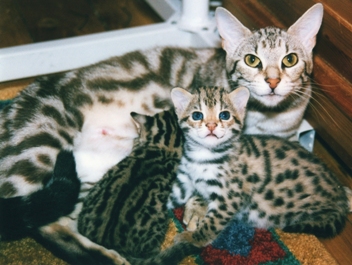 Only
a few breeders in the world
have hybridised from one,
and it is almost unheard of that two
leopard cats have bred with domestic
cats in the same facility! This is a great testament to our cats…and
to how they’ve been raised.
Only
a few breeders in the world
have hybridised from one,
and it is almost unheard of that two
leopard cats have bred with domestic
cats in the same facility! This is a great testament to our cats…and
to how they’ve been raised.
These two events are the pinnacle of all our achievements, and Sarah and I are proud that we’ve created two new pedigree lines of the Bengal cat - something that is so important when the more robust wild blood gene pool is so small.
Eppie (F2 Mother) &
Sarez Nema (Left) & Ebony (Both 75% Wild Blood F1 Kittens) -
August 2001 
Sarez Pow Wow (75% W/B F1) - 22nd
May 2002
 Due
to his £100,000 price tag, the press declared Zeus
to be the world’s most expensive cat
and before he was 6 months old, he had taken the world by storm,
starring on 7 national TV programmes (and many
more world-wide), and in dozens of newspapers and magazines,
behaving impeccably on all.
And he’s still famous today, as one can
see on the internet.
Due
to his £100,000 price tag, the press declared Zeus
to be the world’s most expensive cat
and before he was 6 months old, he had taken the world by storm,
starring on 7 national TV programmes (and many
more world-wide), and in dozens of newspapers and magazines,
behaving impeccably on all.
And he’s still famous today, as one can
see on the internet.
Sarez Zeus (90% Wild Blood F1 Male)
- 26th August 2003
Sarah and I have now bred many F1s and we always keep the fertile females (we still own all but one that exist in Britain), whilst finding good homes for the infertile males. Our cats prove that hybrids and other filial Bengals can make trustworthy, devoted and affectionate pets, if they are reared and kept in the correct manner. And even though we scrutinise the prospective new homes of all our kittens, F1s will always be different and more sensitive compared to the rest, and so we’re extra careful where they go; we always ensure that their new families are permanent, experienced and can provide the right environment and care.
Some of our early generation Bengals such as Sarez Zeus are expensive because of their rarity and because of the vast amounts of money it costs us to breed them (and their forebears), but many of our kittens are far more affordable. With the motto “small enough to care, big enough to share”, we welcome cat lovers from all walks of life; from every day people to an eclectic mix of famous admirers, including His Majesty the Sultan of Brunei, Lady Miranda Rothschild, Lord Jeffrey Archer, Lord and Lady Nourse, the Lord Justice of Appeal, Jonathan Ross, and hedge fund billionaire, Louis Bacon - and that’s to name just a few.
“Exemplifying a perfect harmony of a felid appearance and the alluring personality of a puppy, Esmond Gay’s kittens are unique - the best of the best…”
The London Magazine (2003)
However, not everything is about money and so there’s another side to this spectrum … We have not forgotten our roots, or how we started breeding, or those who enabled us to fulfil our dreams, many years ago. And so we sometimes give kittens away free of charge, if we feel that the homes are devoted to cats and simply can’t afford to buy one - it’s an honour being able give something back and to enable others to enjoy the same pleasures that we get out of this amazing breed.
Due to the popularity of our kittens, most are booked soon after birth, but as they’re not ready to leave us until they’re 13 weeks old, we encourage their new families to visit them as often as they can. This helps to build a strong relationship between them and their baby and when the kittens do eventually leave us, it ensures that the transition into their new home is far less stressful.
SBT Sarez Bengal Kittens - Circa
December 1995 
In February 1996, Sarah and I even set up a club, primarily for those who adopted our babies, but as word spread, it soon grew to become Britain’s largest Bengal cat club, with several hundred members. We called it the Friendly Bengal Cat Club because we wanted to emphasise that, unlike some others, ours was a family orientated, informal and close-knit club. And the F.B.C.C.’s ideals lay not just with the Bengal… because of our love of wild cats, and knowing that many people own Bengals because of their exotic ancestors, the club was also dedicated to them.
The F.B.C.C. did many things, but our most memorable were two excursions, one on the 3rd of November 1996 and another in August 1997, to two world renowned Hertfordshire wild cat charities, one called the Cat Survival Trust, run by Terry Moore, and the other called the Santago Rare Leopard Project, run by Peter James. Sarah and I already worked alongside these two charities due to our Sarez Wild Cat Conservation Programme, in which we keep our own African leopards, ocelots, servals and the rarer subspecies of leopard cat, and we felt that our members would really enjoy the beautiful inhabitants of these charities and at the same time, the club could raise a great deal of money for them.
C.S.T.’s Terry Moore Receiving
Donation from Esmond Gay & F.B.C.C. Members - August 1997 
Unfortunately, we had to close this popular club after a few years - we had many members, a mass of support, superb media publicity, many celebrity patrons and good funding - but Sarah and I simply could not run it on our own, and it had become too big for others to want to run. We were very sad, but our priorities lay with our own vast family of animals - by then, not only were we working up to 18 hours a day, 7 days a week caring for our Bengals and wild cats, but our time was also taken up by another worthy cause…
The Sarez Animal Rescue Sanctuary was created when Sarah and I went to an abattoir to get food for our wild cats - we were so disturbed by what we saw, that from that day on, we started taking in any animals that either are due to be put down or that require a permanent, loving home. I've never been able to understand how people can harm animals; shooting some for “sport”, using others as hard labour, neglecting and abusing the most vulnerable. They all have characters and they all feel pain. And so it feels good being able to help these innocent creatures… emotions that no doubt stem from childhood events.
Whilst our family home contains parrots, genets, a red fox, raccoons, pythons, a lemur and a monkey, to name but a few, in our fields roam a 3-legged pig, road injured deer, llamas, ex-battery birds, ancient geese, ducks, swans, deformed rheas, a 55 year old donkey, and many more. And some of my happiest moments are spent in our fields with our beautiful animals flocking around me as I feed them. And when the media started dubbing me “Dr. Doolittle” because of our menagerie, I really didn’t mind!
Esmond Gay & Sarez Sanctuary
Animals - 11th April 2001 
However, not everyone appreciates the work that we try to do. The British Bengal fancy does have some wonderful and friendly breeders, but it also has its share of spiteful ones. My fiancée and I have tried to fit in, but when we dared to deviate from the norm, when we bought and bred cats that others couldn’t, and when our kittens became popular with the press and the public, a few became quite vindictive…
I may sometimes court with the boundaries of controversy, occasionally I may struggle to conform to the restrictions of the rat race, perhaps I am a little eccentric - but these traits do not make a person or their breeding programme bad or wrong. Yet, Sarah and I have been forced to defend ourselves and our work from a barrage of bitter personal attacks, from lies, innuendos and from plain malicious backbiting.
S o
unjust was this persecution that the media jumped in to protect us,
and one of the subsequent articles was a 5,000 word front
page cover story printed on the 25th of August
1996 in The Mail on Sunday and
entitled “Fur and Loathing”. In it,
an investigative reporter exposed the truth, by
interviewing many of our clients and supporters, and to ensure no
bias, he also spoke to all our detractors as well. The result was a
glowing report of our cats, our breeding practices and our pricing
structure. And it also contained a scaling condemnation of some other
breeders… one (who had tried in vain to buy Michael Pont’s
cats) even ridiculed my depression during her interview, and then
added afterwards, that she: “wouldn’t stop her hate
campaign until she’d destroyed me”. Yet, I barely
knew her!
o
unjust was this persecution that the media jumped in to protect us,
and one of the subsequent articles was a 5,000 word front
page cover story printed on the 25th of August
1996 in The Mail on Sunday and
entitled “Fur and Loathing”. In it,
an investigative reporter exposed the truth, by
interviewing many of our clients and supporters, and to ensure no
bias, he also spoke to all our detractors as well. The result was a
glowing report of our cats, our breeding practices and our pricing
structure. And it also contained a scaling condemnation of some other
breeders… one (who had tried in vain to buy Michael Pont’s
cats) even ridiculed my depression during her interview, and then
added afterwards, that she: “wouldn’t stop her hate
campaign until she’d destroyed me”. Yet, I barely
knew her!
However, the reporter seemed to like us, and later bought a kitten.
Baby Gem (F1) - 2nd Half
of 1995
Esmond Gay - Two of Five Pages in
The Mail on Sunday - 25th August 1996 
B ut
the same seems to occur in any field; there will always be those
who act decisively for a belief or a goal… and there will also
always be those who refuse to act, and who instead, simply pick apart
the efforts of the rest. That’s life. That’s
human nature… and that’s one of the reasons why I turned
to animals many years ago.
ut
the same seems to occur in any field; there will always be those
who act decisively for a belief or a goal… and there will also
always be those who refuse to act, and who instead, simply pick apart
the efforts of the rest. That’s life. That’s
human nature… and that’s one of the reasons why I turned
to animals many years ago.
Bald n’ Beautiful Manky &
Sarez Bengal Kitten - Circa March 2001
Sphynx cats are as dainty as ballerinas, and their soft, suede skin feels like a cuddly hot water bottle… making stroking them, almost addictive! And they fit right into our family because, like the Bengal, they’re incredibly loving and very playful!
Years ago as Sarah and I looked through that book, never could we have envisaged where it would all lead. Back then, we just wanted a spotted pet cat… yet now we live with so many more amazing creatures. From the docile to the wild… from the most expensive to the least wanted… from the plain to the exquisite - these wondrous animals all share our home, our lives and our hearts.
And we are well aware of what made it all possible… the mischievous, rambunctious, yet ever loving relative of the leopard cat…
The beautiful Bengal cat!
C. Esmond Gay
Sarez Bengals
Copyright 2004 C. Esmond Gay
Dedicated to Sarah
Retirement Addition (2008)
Sarah and I achieved a phenomenal amount during the 11 years that we bred Bengals and many of our accomplishments are still unsurpassed. We obsessively chased every one of our goals and ambitions and didn’t stop until we had succeeded. And everything we did was meticulous and done to perfectionist standards.
However, this entailed working up to 18 hours a day, 7 days a week, and with few breaks or holidays. In hindsight, we did too much too fast because the enormous stress that we put ourselves under, plus looking after hundreds of animals almost single-handedly, took its toll on us mentally, emotionally and physically. By 2004, Sarah and I were suffering from severe exhaustion and so reluctantly, we retired. We hoped to lead a quieter life in Latin America, living and working with their endangered cats.
Our larger wild felines went to wildlife parks, our rescued animals went to sanctuaries and private homes, whilst many of our Bengals and leopard cats went to Pauline and Frank Turnock of Gayzette Bengals - they look after and nurture our cats, and are expanding the breeding programme that we worked so hard to create.
I stay in regular contact with Pauline and Frank and offer them my support and advice on the Bengal and wild cats. I follow their achievements, and behind the scenes, I am there for them and for the beautiful cats that we once so proudly owned.
To Sarah and me, our
cats were more than just pets or breeding animals - they were our
family. And within the articles I wrote, my deeply emotional
descriptions of them and how they influenced our lives, portrays just
how powerfully I love them; and so naturally, I feel terrible loss
and miss them tremendously. However, I am grateful for the 11
wonderful years that they graced our home, and for the honour and
privilege of being able to share part of my life with them…
and for the amazing memories that they’ve left me with.
C. Esmond Gay

